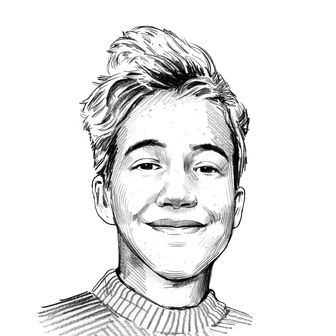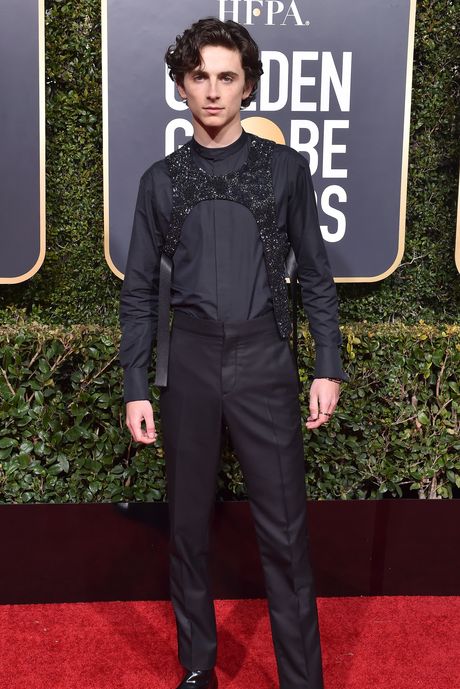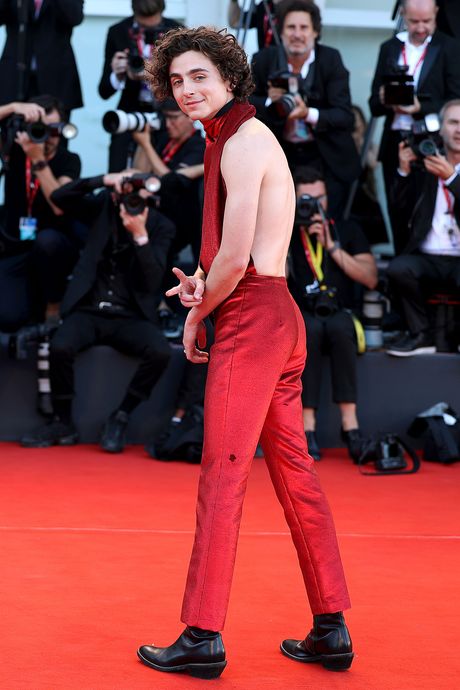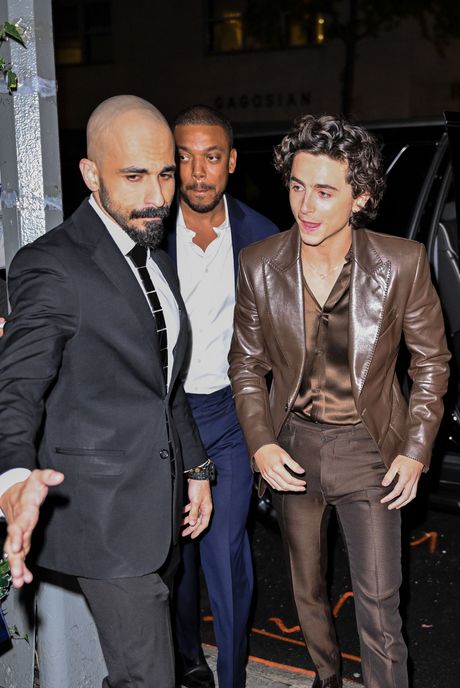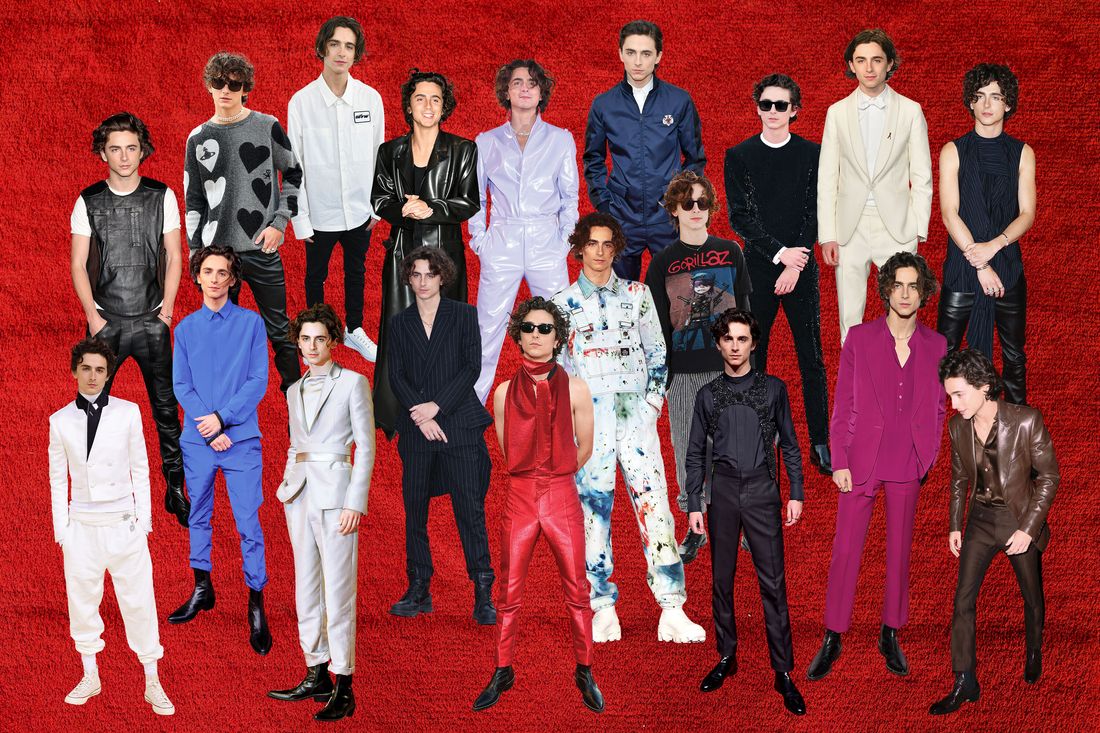
Timothée Chalamet wears an Off-White jacket that Nick Kroll jokes makes him look like a gas-station attendant. He wears a Vuitton bib-cum-harness embroidered with sequins and caviar clusters of black beads. He wears archival Helmut Lang. He wears a Gorillaz T-shirt. He wears a slinky red Haider Ackermann halter top that shows a broad, pale swath of back. There are common elements to these outfits — the matching shirts and pants, the stiff and glossy with the flowy, the deliberately artless rolled-up pant cuffs — that show a private sensibility at work: an appreciation of balance and of fine materials, a need for a bit of patina. Over and over he wears the same Ackermann cowboy Chelsea boots, black and curvy with a thick slice of heel.
Chalamet began his rise to boy of the Zeitgeist while riding on the success of the gay movie that fashion people loved. He was a loyal wearer of Virgil Abloh, whom he followed from Abloh’s own brand, Off-White — he wore that gas-station-attendant jacket to the Independent Spirit Awards in 2018 — to Louis Vuitton’s menswear. To the 2019 Golden Globes, he wore the black bib-harness, a recurring style in Abloh’s first Vuitton collection that never really took off otherwise. (Abloh died in 2021; Chalamet posted a tribute on Instagram ending with Dylan Thomas’s poem “Do not go gentle into that good night.”) He sat in the front row at Paris Fashion Week. He became a fashion monster.
His evolution was pushed along by a snowmelt river of clout for publicly straight cisgender men wearing gender-expansive clothing, a period roughly from 2016 to 2021. Male celebrities dressing in anything but traditional menswear have historically gotten strong reactions — see Dennis Rodman with his wedding dress and tiny tank tops. But in the mid-aughts, the organs of mainstream image production began to openly adopt signifiers of gay, queer, gender-expansive, and transgender style, and reactions skewed positive. There was Young Thug in a Dutch blue dress by Alessandro Trincone on the cover of his album Jeffery. Harry Styles in a pearl earring and lacy sheer top at the Met Gala, then in a dress on the cover of Vogue. Bad Bunny twerking in drag, wearing perfect fake tits and latex. Lil Uzi Vert’s kilts and off-the-shoulder mall goth sweaters.
There was a heady, queasy feeling about this. It was as if by publicly liking these outfits, one could avail oneself of a sense of progressive moral good, even though the asymmetries in power between celebrities and the places where these styles had originated were glaring. But everything was in motion. Maybe this meant things were changing; maybe this would change things.
By the 2020s, more queer and trans celebrities had entered the fashion Establishment — Lil Nas X pole-dancing into hell, Doctor Barbie Hari Nef — and people were, for the most part, no longer getting blogged about for wearing a skirt. As the clout freshet ebbed, Timothée kept dressing. In fact, it became easier to appreciate that he was an interesting dresser all along: a sensualist with an appreciation for glossy fabrics and monochrome, the kind of fashion consumer who loves being close to designers and texts them hoodie ideas or, in the case of Ackermann, a quick “I love you, bro.” (As Ackermann explained it: “We understand one another like old souls — people with the same sensibilities always find one another.”)
Chalamet doesn’t have the natural comprehensiveness of a Rodman. He’s not a truffle pig for emerging designers like Julia Fox or ’90s Chloë Sevigny, patron saints of fashion students working at their kitchen tables. Instead, he has the taste of a person who got into fashion once they were already famous. For him, an artsy fit is a pair of overalls made by Gagosian-represented artist Sterling Ruby’s clothing brand; the working man’s version of the same outfit might come from a more interesting, scrappier L.A. designer like Come Tees or 69. It’s sort of charming how bland his street style can be compared to his bravura dressing for events.
The lore is that Timothée does not have a stylist. This isn’t entirely true — he’s worked with Erin Walsh in the past and has recently started working with Ryan Hastings — but some of his best, most distinctive looks fall outside those collaborations: the Louis Vuitton bib, an electric blue shirt and matching pants by Ackermann. In 2019, he wore a silver Ackermann suit to the premiere of The King, cinched around the waist with a loop of two-faced satin like a cummerbund, glossy on one side and matte on the other. Instead of a shirt, his chest was covered by a panel of silk that hung down from his collarbones like beaten pewter. He loves to dress to a prompt — complicated tailoring and smooth surfaces for his Dune press tour, slutty little tops for Bones and All, latex and brown leather for dating Kylie Jenner — but the theory behind it is coherent, the same ideas and shapes recurring, tweaked or refined each time. This is a fashion monster evolving into a fashion adult.
Correction: Chalamet’s stylist is Ryan Hastings. A previous version of this story misstated who he is currently working with.
More From timmy wéek
- Timothée Chalamet Has Been Playing Great Bad Boyfriends Since Homeland
- We Néed Timmy’s É
- Whither Timothée Chalamet’s Bleu de Chanel Commercial?


